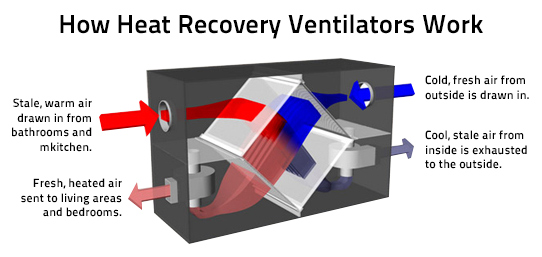HRV Shopping Tips: What Features to Consider
Wiki Article
Discovering the Conveniences of Heat Recovery Ventilation for Power Efficiency in Houses
Heat Recovery Ventilation (HRV) systems use property owners a practical technique to boosting energy performance. By recovering warm from outward bound air, these systems can significantly lower heating and cooling costs. In addition, they offer a stable supply of fresh air, improving interior air quality and convenience levels. As homeowners consider lasting options, recognizing the subtleties of HRV systems becomes increasingly crucial. What factors should one review prior to making such a financial investment?Understanding Heat Recovery Ventilation Systems

Exactly How HRV Boosts Indoor Air Top Quality

Energy Cost Savings: The Financial Advantages of HRV
Taking full advantage of energy performance, heat recovery ventilation (HRV) systems supply significant economic advantages for home owners. By recouping and recycling warmth from exhaust air, HRVs considerably minimize heating & cooling costs. This technology can lead to energy financial savings of up to 30%, depending on climate and use patterns. Home owners commonly see lowered energy expenses shortly after installation, making HRVs a financially sensible financial investment with time. In addition, many regions offer rewards or refunds for energy-efficient upgrades, better enhancing the monetary appeal. As power prices continue to climb, the cost-effectiveness of HRVs ends up being increasingly clear. Overall, the incorporation of HRV systems not only advertises energy effectiveness yet likewise contributes to long-lasting economic savings for houses.The Ecological Influence of Heat Recovery Ventilation
A substantial ecological advantage of heat recovery ventilation (HRV) systems lies in their capability to decrease total energy intake. By reclaiming warmth from exhaust air and transferring it to incoming fresh air, HRV systems reduce the requirement for energy-intensive home heating and cooling down approaches. This reduction in energy demand adds to reduce greenhouse gas exhausts, as much less fossil gas is needed to preserve comfortable interior temperature levels. Furthermore, HRV systems improve interior air top quality by efficiently trading stagnant air with fresh exterior air, decreasing reliance on mechanical air conditioning systems that can hurt the setting. On the whole, the execution of HRV systems supports sustainable living techniques and lines up with Your Domain Name global efforts to fight climate modification by advertising energy efficiency in residential settings.
Choosing the Right HRV System for Your Home
How can home owners ensure they pick the ideal heat recovery ventilation (HRV) system for their demands? They must analyze their home's dimension and layout, as these factors affect air flow requirements. Next off, evaluating the system's performance scores is vital, as greater ratings show much better performance and power cost savings. Home owners ought to additionally think about setup and maintenance prices, comparing various brand names and versions for value. Additionally, it is very important to evaluate noise degrees, as some systems operate even more silently than others. Consulting with HVAC professionals can offer customized referrals based upon details home problems. Finally, analyzing customer testimonials and guarantees can aid in making an educated decision, making certain that the picked HRV system effectively improves interior air high quality and energy effectiveness.Regularly Asked Questions

Just how Often Should I Tidy or Keep My HRV System?
The frequency of cleaning or keeping a warmth recuperation ventilation (HRV) system commonly relies on usage and ecological elements. Typically, it is recommended to execute upkeep every 6 months to ensure peak performance and air quality.
Can HRV Systems Help In Reducing Humidity Degrees Indoors?
HRV systems can successfully lower interior humidity degrees by trading stagnant, moist air with fresh, drier air from outdoors. HRV Heat Recovery Ventilation. This procedure helps maintain a balanced indoor setting, improving comfort and preventing moisture-related issues
What Is the Lifespan of a Typical HRV System?
The life-span of a typical heat recovery ventilation (HRV) system varies, normally lasting in between 10 to 15 years. Routine maintenance can prolong its performance and functional life, guaranteeing peak performance throughout its use duration.Exist Any Sound Worry About HRV Solutions?
Noise problems with HRV systems can develop, particularly read this post here from fan procedure. However, several modern-day units are created to lessen sound levels, ensuring they operate quietly while keeping performance, which deals with possible disruptions in living atmospheres.Can I Install an HRV System Myself, or Do I Need an Expert?
The individual contemplated whether to mount the heat recovery ventilation (HRV) system personally or employ a specialist. Generally, while DIY installation is possible, proficiency warranties browse around these guys correct performance and compliance with regional building regulations, boosting system effectiveness.Report this wiki page